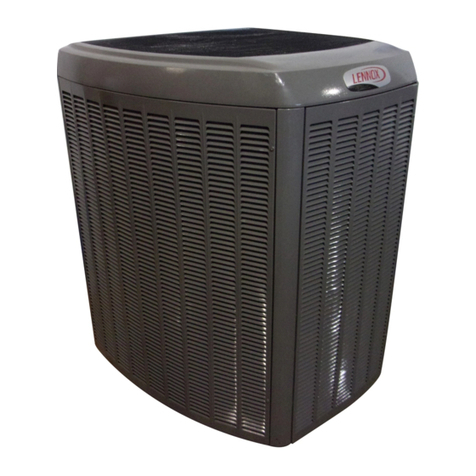Northern Heatpump NorthStarRA-WE-036 Manual

09/11/2014 NI701
Water to Water Geothermal Heat Pump
Installation & Operating Instructions
Model: RA-WE* (Single Compressor)
R -WE* ( ual Compressor)
Application
Geo source loop or ground water fluid
Load water heat/cool output
Low temperature, radiant floor heating
ir handler larger water coil, heat/cool
Tested to UL Standards 1995 and CS Standards C22.2
3-Phase Models
lso see and use NI704
Domestic Water Heater, Desuperheater
Energy Star promotes the desuperheater; however, it
only efficiently produces hot water if the tank
temperature is less than 115° F (46° C). hot water
buffer tank is suggested for proper and efficient
application, see page 19.
Drawings: NR701, NR705, NR70 , UAW701, UAW705, XX029
DO NOT DESTROY THIS MANUAL. PLEASE READ CAREFULLY AND KEEP IN A SAFE
PLACE FOR FUTURE REFERENCE BY A SERVICE TECHNICIAN.
Northern Geo LLC
75 West Veum
Appleton, MN 56208
320-297-9100
www.northernheatpump.com [email protected]

09/11/2014 NI701
Table of Contents
Introduction 1
Product Configurator (NC028) 2
Mechanical Specifications 3
Single Compressor 3
Dual Compressor 4
Electrical Data 5
Single Compressor 5
Dual Compressor 5
Product Dimensions 6
Installation Requirements 9
Mechanical Installation Overview 10
Mechanical Installation Source Water 11
Flushing and Filling Procedure 14
ntifreeze 15
Open Loop/Well 16
Desuperheater, Domestic Hot Water 18
Hydronic (Load), Space Water Heating, Installation 20
Electrical Hookup 22
Control Wiring 23
Operation Indicators 24
Troubleshooting 26
Preventative Maintenance 29
ccessories/Options 30
Drawings NR701
NR705
NR706
U W701
U W705
XX029

09/11/2014 1 NI701
Introduction
When used and controlled properly, geothermal heat pumps can save hundreds of dollars per year. NorthStar
Series geothermal heat pumps are designed to provide maximum efficiency, comfort, and reliability. Solid and
simple electric controls allow for low maintenance and built in safety protection.
Compressor safety and limit shutdown is included with the standard ICM control board. However, operational
control is considerably simpler and limited to an aquastat type contact closure wired between terminal block R
and HW screws. Cooling is activated with a contact closure between R and O.
The RD-WE Series is commonly referred to as “Dual Compressor”. This is more than two compressors; it is
two complete refrigerant loop systems, feeding through a single but isolated two section heat exchanger. This
provides increased efficiency plus each operates independently and can serve as a failure backup.
Pump (loop and hydronic) connections are provided, with inline fuses.
Moving and Storage
Units should be stored in original packaging in a clean dry area. Store and move units in normal upright
position. Do not stack units.
Initial Inspection
Be certain to inspect all cartons and crates as units are received before signing the freight bill. Verify that all
items received have no physical damage. Report any damages or shortages on the freight bill. The purchaser is
responsible for filing the necessary claims with the carrier. Concealed or hidden damages not discovered until
removing packaging must be reported to the carrier within 15 days of receipt.
Unit Location and Mounting
Locate the unit in an indoor area where the ambient temperature will remain above 45°F [8°C]. Northern Heat
Pump provides 4 removable panels (all 4 sides) for servicing ease. This unit is zero clearance rated; however,
allow enough room to remove panels for service and maintenance. Suggest setting unit on a sound vibration
pad, see accessories price sheet, R-P D-2735-1-**. Water supply should not be hard plumbed directly with
copper pipe as this could transfer any vibration to living space.
Please read and understand conditions associated with proper installation, unauthorized changes, and POWER ON
procedures.
Warranty Statement
See the last pages of this manual for detailed limited warranty coverage explanation.
Safety Considerations
WARNING
BEFORE PERFORMING SERVICE OR MAINTENANCE OPERATIONS ON A SYSTEM, TURN OFF
MAIN POWER SWITCHES TO THE INDOOR UNIT. IF APPLICABLE, TURN OFF THE ACCESSORY
HEATER POWER SWITCH. ELECTRICAL SHOCK COULD CAUSE PERSONAL INJURY.
Installing and servicing heating and air conditioning equipment can be hazardous due to system pressure and
electrical components. Only trained and qualified service personnel should install, repair or service heating and
air conditioning equipment. Untrained personnel can perform the basic maintenance functions of cleaning coils
and cleaning and replacing filters. ll other operations should be performed by trained service personnel. When
working on heating and air conditioning equipment, observe precautions in the literature, tags and labels
attached to the unit and other safety precautions that may apply, such as the following safety measures:
Follow all safety codes.
Wear safety glasses and work gloves.
Use a quenching cloth for brazing operations.
Have a fire extinguisher available for all brazing operations.

09/11/2014 2 NI701

08/19/2014 3 NI701
RA-WE – Mechanical Specifications – R41 A Single Stage Compressor
MODEL RA-WE-036
(3 on)
RA-WE-050
(4 on)
RA-WE-060
(5 on)
RA-WE-072
(6 on)
Source & Load GPM – Hea ing 12 16 15 18
Source & Load GPM – Cooling 12 16 15 20
Fac ory Charge R410A 3 lbs. 14 oz. 4 lbs. 8 oz. 6 lbs. 6 oz. 7 lbs. 8 oz.
Source Temperature °F (min/max)
20°/120°
20°/120°
20°/120°
20°/120°
Wa er Connec ion (NPT – female) 1” 1” 1-¼” 1-¼”
Hea Exchanger Type Coax Coax Coax Coax
Loop Coil & Piping Wa er Volume (gal) .77 1.1 1.38 2.3
Load Coil Wa er Volume (gal) .98 .98 1.38 2.3
Desuperhea er Connec ion (NPT – female) ½” ½” ½” ½”
Weigh – Packaged (lbs) 340 345 525 575
Wid h of Cabine (inches) 27 27 25 25
Heigh (Inches) 29 29 49 49
Dep h (Inches) 35 35 32 32
HEAT EXCHANGER PRESSURE DROP TABLE
Water-to-Water (Source Side and Load Side, Pure Water @ 68° F
Model GPM PSID Model GPM PSID Model GPM PSID Model GPM PSID
3-ton
6 2.
4-ton
8 1.3
5-ton
12 1.84
6-ton
16 1.8
9 3.6 12 2.5 14 2.24 18 2.34
12 5.5 16 4. 15 2.44 2 2.86
15 7.8 2 5.8 17 3. 3 23 3.8
PRESSURE DROP MULTIPLIERS
Freeze Point (° F) 20° F 25° F 30° F 35° F 40° F
Pure Water Multiplier 32.0 1.00 1.00 1.00 1.00 1.00
Methanol 12.5 * Multiplier 16.2 − 1.25 1.21 1.18 1.15
Propylene Glycol 20 * Multiplier 18.4 1.39 1.35 1.31 1.28 1.24
Ethanol 20 * Multiplier 18.1 1.56 1.47 1.42 1.36 1.31
*By volume Feet of Head = PSI x 2.31
ISO 13256-2 Performance – Energy Star
Model
Source
/ Load
GPM
Ground Water Heat Pump Ground Loop Heat Pump
Cooling 59°F Heating 50°F Cooling
Full Load 77°F
Heating
Full Load 3 °F
Capacity
Btu/h
EER
Btu/h/W
Capacity
Btu/h COP Capacity
Btu/h
EER
Btu/h/W
Capacity
Btu/h COP
RA-WE-036 12 / 12 40100 20.7 43900 3.7 36600 16.1 32300 3.1
RA-WE-050 16 / 16 55100 20.1 60100 3.6 54200 16.1 45200 3.1
RA-WE-060 15 / 15 65000 20.4 68000 3.7 58200 16.1 52000 3.1
RA-WE-072 18 / 18 75000 20.1 80500 3.7 71900 16.1 62900 3.1
Heating capacities based upon 1 4°F hydronic return water.
Cooling capacities based upon 53.6 F hydronic return water.
Ground Loop Heat Pump ratings based on 15% antifreeze solution.
All ratings based upon operation at lower voltage of dual voltage rated models.

08/19/2014 4 NI701
RD-WE – Mechanical Specifications – R41 A Dual Compressor
MODEL RD-WE-096
(8 on)
RD-WE-120
(10 on)
RD-WE-144
(12 on)
Source & Load GPM – Hea ing 16 20 24
Source & Load GPM – Cooling 16 20 24
Fac ory Charge R410A* 4 lbs. 2 oz. x (2*) 4 lbs. 2 oz. x (2*) 4 lbs. 2 oz. x (2*)
Source Temperature °F (min/max)
20°/120°
20°/120°
20°/120°
Wa er Connec ion (NPT – male) 1-½” 1-½” 1-½”
Hea Exchanger Type Brazed pla e Brazed pla e Brazed pla e
Loop Coil & Piping Wa er Volume (gal) 1.62 1.62 1.62
Load Coil Wa er Volume (gal) 1.62 1.62 1.62
Weigh – Packaged (lbs) 510 525 535
*Dual compressor models con ain dual refrigera ion circui s, amoun shown is for each circui .
HEAT EXCHANGER PRESSURE DROP TABLE
Water-to-Water (Source Side and Load Side, Pure Water @ 68° F
Model GPM PSID Model GPM PSID Model GPM PSID
8-ton
12 0.79
10-ton
15 1.10
12-ton
16 1.21
14 0.99 16 1.21 17 1.33
15 1.10 17 1.33 18 1.45
16 1.21 18 1.45 20 1.71
17 1.33 20 1.71 22 2.00
18 1.45 22 2.00 23 2.14
20 1.71 23 2.14 24 2.30
22 2.00 24 2.30 25 2.46
23 2.14 25 2.46 26 2.62
24 2.30 26 2.62 27 2.79
25 2.46 27 2.79 28 2.96
26 2.62 28 2.96 30 3.32
27 2.79 30 3.32 32 3.98
28 2.96 32 3.98 34 4.02
30 3.32 34 4.02 36 4.53
PRESSURE DROP MULTIPLIERS
Freeze Point (° F) 20° F 25° F 30° F 35° F 40° F
Pure Water Multiplier 32.0 1.00 1.00 1.00 1.00 1.00
Methanol 12.5 * Multiplier 16.2 − 1.25 1.21 1.18 1.15
Propylene Glycol 20 * Multiplier 18.4 1.39 1.35 1.31 1.28 1.24
Ethanol 20 * Multiplier 18.1 1.56 1.47 1.42 1.36 1.31
*By volume Feet of Head = PSI x 2.31
ISO 13256-2 Performance – Energy Star
Model
Source
/ Load
GPM
Stage
Ground Water Heat Pump Ground Loop Heat Pump
Cooling 59°F Heating 50°F Cooling
Full Load 77°F/68°F
Heating
Full Load 3 °F/41°F
BTUh EER BTUh COP BTUh EER BTUh COP
RD-WE-096 16 / 16 FL 103000 19.7 110200 3.5 95700 15.7 86900 2.9
PL 55100 21.5 58200 3.8 53100 18.3 52200 3.5
RD-WE-120 20 / 20 FL 120000 19.5 128000 3.5 103200 15.6 99900 2.8
PL 64000 21.0 71500 3.8 57000 18.1 55500 3.5
RD-WE-144* 24 / 24 FL 137500 19.0 147600 3.4 126000 14.4 121000 2.7
PL 73500 20.2 78500 3.7 70000 18.0 68500 3.3
Heating capacities based upon 1 4°F hydronic return water.
Cooling capacities based upon 53.6°F hydronic return water.
Ground Loop Heat Pump ratings based on 15% antifreeze solution.
All ratings based upon operation at lower voltage of dual voltage rated models.
*RD-WE-144 is outside the scope of AHRI and Energy Star.

08/19/2014 5 NI701
RA-WE – Electrical Data – Single Phase
Model
Voltage
Compressor
Load
Pump
Desup.
Pump
Source
Pump
Total
Min.
Max.
Fuse/
H CR
(60 Hz)
RL
LR
FL
FL
FL
FL
mpac.
R -WE-036 208/230-1 17.9 112 1.8 .15 4.4 24.3 28.7 40
R -WE-050 208/230-1 26.4 134 1.8 .15 4.4 33.3 39.2 60
R -WE-060 208/230-1 28.3 178 1.8 .15 4.4 34.7 41.7 60
R -WE-072 208/230-1 36.9 185 1.8 .15 4.4 43.3 52.5 80
RD-WE – Electrical Data – Single Phase
Model
Voltage
Compressor
Load
Pump
Desup.
Pump
Source
Pump
Total
Min.
Max.
Fuse/
H CR
(60 Hz)
RL
LR
FL
FL
FL
FL
mpac.
RD-WE-096 208/230-1 26.4 x 2 134 x 2 1.8 .15 4.4 33.3 x 2 39.2 x 2 60 x 2
RD-WE-120 208/230-1 28.3 x 2 178 x 2 1.8 .15 4.4 34.7 x 2 41.7 x 2 60 x 2
RD-WE-144 208/230-1 36.9 x 2 185 x 2 1.8 .15 4.4 43.3 x 2 52.5 x 2 80 x 2
Note: Dual compressor models contain dual power circuits for the compressors, amperages shown are for each
circuit. Please refer to NI704 for 3-phase models.

08/19/2014 6 NI701
Product Dimensions – RA-WE- 36 & RA-WE- 5

08/19/2014 7 NI701
Product Dimensions – RA-WE- 6 & RA-WE- 72

08/19/2014 8 NI701
Product Dimensions – RD-WE

08/19/2014 9 NI701
Installation Requirements
1. ll installation work must be performed by trained, qualified contractors or technicians. Northern Heat
Pump, sponsors installation and service schools to assist the installer. Visit our Website at
www.northernheatpump.com for upcoming service schools.
WARNING
ALL ELECTRICAL WIRING MUST BE IN ACCORDANCE WITH NATIONAL ELECTRIC CODE
AND LOCAL ELECTRIC CODES, ORDINANCES, AND REGULATIONS.
WARNING
OBSERVE ELECTRIC POLARITY AND WIRING COLORS. FAILURE TO OBSERVE COULD
CAUSE ELECTRIC SHOCK AND/OR DAMAGE TO THE EQUIPMENT.
CAUTION
This unit can only be used for its intended design as described in this manual. ny internal
wiring changes, modifications to the circuit board, modifications or bypass of any controls, or
installation practices not according to the details of this manual will void the product warranty,
the safety certification label, and manufacturer product liability. Northern Heat Pump, cannot
be held responsible for field modifications, incorrect installations, and conditions which may
bypass or compromise the built-in safety features and controls.
CAUTION
This unit shall not be operated (either heating section or blower) until the interior of the
structure is completed and cleaned. This also means all duct work must be complete with
filter, etc. Manufacturer’s warranty is void if this unit is operated during structure
construction.
CAUTION
Hazards or unsafe practices could result in property damage, product damage, severe personal
injury and/or death.
2. ll removed or discharged refrigerant must be recovered. Local and federal statutes are to be observed.
Should a compressor need replacing, the compressor oil is to remain with the compressor. Refrigerant lines
on the compressor must be sealed.
3. Remember, safety is the installer’s responsibility and the installer must know this product well enough to
instruct the end user on its safe use.
t Northern Heat Pump, the safety of the installer and the end user is of highest priority. Remember, safety is
the installer’s responsibility and the installer must know this product well enough to instruct the end user on its
safe use. Professional installers should be trained and experienced in the areas of handling electrical
components, sheet metal products, and material handling processes.

08/19/2014 10 NI701
Figure 1
Horizontal losed Loop
Mechanical Installation Overview
This NorthStar Series unit cannot heat or cool energy by itself. Heat pumps use the fluid in the source loop as
the energy source. Thus the design and installation of the source fluid system may be the most important part of
this heat pump system. The following items should be carefully considered and properly followed for all
installations:
Heating capacity – Size the geothermal heat pump according to the normal heating requirements as the
building exists today. Do not necessarily match to the existing furnace nameplate because it may be oversized.
Do not oversize the geothermal heat pump.
Closed Loop Applications – Closed loop system re-circulates the same water/antifreeze solution through a
closed system of underground high-density polyethylene pipe. s the solution passes
through the pipe it collects heat (in the heating mode) that is being transferred
from the relatively warm surrounding soil through the pipe and into the
relatively cold solution. The solution is circulated back to the heat pump that
extracts its heat and then returns to the ground to absorb more heat from the
earth. Earth loops must be sized properly for each particular geographic area
and individual capacity requirements.
The NorthStar Series heat pumps are designed to operate on either vertical
or horizontal closed loop applications. (Figures 1 & 2) Vertical loops are typically
installed with a well drilling rig up to 200 feet (60 m) deep or more. Horizontal
systems are typically installed with excavating or trenching equipment approximately
six to eight feet deep, depending on geographic location and length of pipe
used.
Lake or Pond Loops – Closed loop systems may also be used in lakes or rivers
to supply a heat source to the heat pump. Typically a loop consisting of
geothermal pipe can be designed and placed in an area not much deeper than
15ft (4.5 meters) with some water currents present. In any lake or pond,
municipal and area codes must be observed in regards to a lake or pond loop.
The use of an environmentally friendly loop fluid like food grade propylene
glycol should be considered if the loop was ever damaged. Consult an IGSHP
or CGC certified installer for proper lake or pond loop design.
Figure 2
Vertical
losed Loop

08/19/2014 11 NI701
Mechanical Installation Source Water
WARNING
LOOP DESIGN IS EXTREMELY IMPORTANT FOR PROPER HEAT PUMP OPERATION.
INCORRECT LOOP DESIGN WILL REDUCE HEAT PUMP EFFICIENCY, CAUSE POOR
PERFORMANCE OR MAY RENDER THE SYSTEM UNUSABLE. CONTACT AN IGSHPA OR
CGC CERTIFIED GEOTHERMAL LOOP CONTRACTOR FOR PROPER INSTALLATIONS.
Water Connections General
The following pages outline typical piping arrangements for the most common source water connection options,
as well as flushing and filling procedures and antifreeze requirements for closed loop systems. Do not connect
copper piping directly to the source water connection points on this unit. section of flexible piping is
recommended to reduce and isolate vibrations transmitting from the compressor into other parts of the system.
This manual covers wide range of heat pump capacities. s a result water connections show one representative
cabinet size. Exact water connection locations and size vary based upon these ranges, (2-1/2 ton – 4-ton), (5 – 6
ton), and (8 – 12 ton). See product dimension pages at the beginning of the manual for exact location and pipe size.
Once closed loops are completed, they must be pressure tested to at least 60 PSI to insure integrity. Once
pressure is tested, loop must be purged of all foreign debris and filled with fluid. ll air must be removed at this
time by flushing the system. (Table 2) shows approximate fluid volumes.
Flow Switch – depending upon the model series and size the mounting and field installation requirement
differs.
R -WE-030, 036, 050 – factory mounted internal and provided complete
R -WE-060, 072 – loose kit, field installed external, wired to ICM board (see diagram below)
RD-WE Series – loose kit, field installed external, wired to ICM board (see diagram below). lso, an
adapter is required for 8-12 ton models. 8-12 ton models have 1-1/2” MPT ports, therefore a field provided
coupling is required to attach the 1-1/4” flow nipple to 8-12 ton models. The flow switch itself is directional
and must be installed facing the correct direction.
Note: The directional arrow is located at the top of the switch and must be pointing toward the heat pump.
Product warranty is void if this flow switch is not installed.

08/19/2014 12 NI701
Figure 3
P/T Adapter
Pressure/Temperature (P/T) plugs – Should be installed in the adaptor elbow on the entering
and leaving water line of the heat pump on a closed system. (Figures 3 and 4) thermometer
can be inserted into the P/T ports to check entering and leaving water temperatures. pressure
gauge can also be inserted into these P/T ports to determine the pressure differential between
the entering and leaving water. This pressure differential can then be compared to the
engineering specifications data to determine the flow rate of the system.
Flow Center – if selecting non-pressure closed loop design (Figure 5), a flow center is required. Flow center is
the key to installation ease and long-term reliability.
Flow Meter is an important part of the system. It provides a visual indicator of loop flow in GPM.
flow meter can be installed on either side of the pump pack, but must be installed per manufacturer
recommendations so it reads accurately.
Non-Pressurized Loops require an air separator/stand pipe to eliminate air and to hold enough fluid to
compensate for the expansion and contraction of the loop pipe and fluid. Purge and fill valves should be placed
between the loop manifold valves and the insulated pump pack. See figure 4.
Pressurized Loops do not require an air separator. They require purge and fill ports between the loop manifold
valves and the insulated pump pack. See figure 5. fter purging a pressurized loop, it should maintain 45 to 60
psi static pressure. The geothermal loop pipe stretches under pressure so may need to be pressurized above the
desired pressure several times to achieve the recommended static pressure. Pressurized loops must maintain
enough static pressure to compensate for the expansion and contraction of the loop pipe and fluid.
Loop Pump Selection – select a loop circulation pump based upon the GPM required and total system pressure
drop. See specification, page 5. Geo heat pump Btu/h capacity and efficiency are directly related to the GPM
flow through the unit.
Vibration pad – We suggest setting the unit on a sound vibration pad, available from most distributors or
accessories price sheet – R-P D-2735-1-**.
Water quality – models with standard copper heat exchanger coils require the installer to evaluate water
quality and meet minimum water properties.
pH/calcium hardness pH < 7.5 and Ca harness < 100 PPM
Iron fouling < 0.2 PPM (Ferrous)
< 0.5 PPM of oxygen
Hydrogen sulfide (H
2
S) < 0.5 PPM
Chloride levels < 20 PPM
Erosion/clogging < 10 PPM, particles
Filter, if required < 800 micron size

08/19/2014 13 NI701
Figure 4 – Pressurized Closed Loop with Flow Center – Typical piping arrangement.*
Figure 5 – Non-Pressurized Closed Loop with Flow Center – Typical piping diagram.*
*4-ton model shown, for water connection locations on other models reference product dimension pages.

08/19/2014 14 NI701
To Earth Loop
From Earth Loop
From
Flush
Cart
To
Flush
Cart
Step 3
From Heat Pump
To Heat Pump
Step 5
To
Flush
Cart
From
Flush
Cart
From Heat Pump
To Heat Pump
To Earth Loop
From Earth Loop
Step 6B
From Heat Pump
To Heat Pump
Step 6A
From
Flush
Cart
Pressurize Loop
Flushing and Filling the System Using 3-Way Valves
Step 1
Use water and a high volume head circulator pump to flush air and debris and to fill the loop system.
• Refer to recommendations provided by IGSHP or CGC when choosing a pump for the flushing process.
• It is recommended that pump suction be from the bottom of a large volume container. Use a suction line
strainer to prevent debris discharged into the container from being recycled to the system.
Step 2
Pump water into the system by connecting the pump discharge hose to one (not both) of the 1.00” NPT water
connections located on the sides of the module.
Connect a return hose to the opposite side of the module to discharge debris and air as water is added to the
loop.
Step 3
Rotate the module valves as shown in step 3 diagram:
Step 4
Start the pump. dd anti-freeze and water to the container as needed so that no air enters the system. This will
push any air out of the loop. If flushing assembly is equipped with valves to reverse flow direction, do so
occasionally to help remove trapped air. When bubbles cease in the return hose container, the earth loop has
been completely flushed.
Step 5
Flush the heat pump. To do so, simply rotate the valves as
shown in step 5 diagram while the pump is running. Flush the
heat pump using the same procedure as used to flush the
earth loop.
Pressurizing the System (does not apply to Figure 5)
Step
fter flushing and filling the system, rotate the module valve
discharging into the flush container as shown in step 6
diagram to pressurize the loop. Then turn the valves as in step
6B.
Step 7
Turn off the flush cart pump. The system should remain
pressurized. Release excess pressure by rotating either
module valve to allow a small amount of water to pass
through and out of the system and into the container. Some
initial loss of pressure can be expected and is due to the
expansion of the earth loop pipe under pressure. The pressure
will stabilize if the system has no leaks.
Step 8
Flushing, filling and pressurization should be complete. Start
the loop pump module circulators.
Step 9
Troubleshoot. If for some reason the circulators are not
operating, power off and diagnose the problem.

08/19/2014 15 NI701
Step 10
Using a single water pressure gauge, measure the pressure drop at the pressure/temperature plugs across the
heat pump heat exchanger. Compare the measurement with the flow versus the pressure drop table (Table#3)
and determine the actual flow rate. If the flow rate is low, recheck the selection of the loop pump module model
for sufficient capacity. If the model is correct, there is likely trapped air or a restriction in the flow circuit.
System pressure should increase rapidly as the flush pump works to force more water into the system.
dditional flushing of the loop is needed if the water level in the loop falls. This shows that there is air in the
system. System operating pressures should be between 10 to 40 PSI.
Antifreeze
DO NOT mix more than 25% propylene glycol with water to achieve a lower than 15°F [-9°C] freeze
protection. (See Table 3) more concentrated mixture cannot be pumped through the earth loop at low
temperatures. Lack of antifreeze will cause unit shutdown problems during cold weather operation (longest unit
run time) when the loop temperatures fall below the freeze protection of the antifreeze. Flow rate requirements
for closed loop solutions are higher than open loop systems because water temperatures supplied to the heat
pump are generally lower. Typically 2.0 to 3.0 gallons per minute (GPM) per ton are required for proper
operation of the heat pump and the earth coupled heat exchanger.
Table 3 – Antifreeze Percentages by Volume*
Minimum Temperature for Freeze Protection
10°F 16°F 17°F 21°F 25°F
Type -12°C -9°C -8°C -6°C -4°C
Methanol 25% 21% 18% 16% 10%
Propylene
Glycol
38% 30% 25% 22% 15%
Ethanol 22% 20% 18% 14% 10%
*Reference information only, see product manufacturer
specification for percentage.
WARNING
DO NOT USE CALCIUM AS ANTI-FREEZE. FOLLOW CGC/IGSHPA RECOMMENDATIONS
FOR THE APPROPRIATE TYPE AND AMOUNT OF ANTI-FREEZE.
WARNING
PREVENTING FREEZE-UP IS INSTALLER/USER RESPONSIBILITY. LEAKING HEAT
EXCHANGER OR PIPING (EXTERNAL OR INTERNAL WITHIN THE REFRIGERANT/
COMPRESSOR) ARE NOT COVERED BY WARRANTY.
Table 2 – Approximate Fluid Volume (gal)
per 100ft
Pipe Size Volume
Polyethylene
¾” IPS SDR 11 2.8
1” IPS SDR 11 4.5
1-1/4” IPS SDR 11 8.0
1-1/2” IPS SDR 11 10.9
2” IPS SDR 11 18.0
Rubber Hose 1” 3.9
Copper
1” 4.1
1.25” 6.4
1.5” 9.2

08/19/2014 16 NI701
Open Loop/Well – n open system gets its name from the open discharge of water after it has been used by the
heat pump. well must be available that can supply all of the water requirements of the heat pump along with
any other water requirements drawing off that same well. The well must be capable of supplying the heat pumps
required flow rated for up to 24 hours per day for the coldest winter day.
The discharge water is typically returned to the earth via a properly designed drain field or in a lake.
Figure 6 shows the necessary components for water piping of an open system. First a bladder type pressure tank
with a “draw down” of at least 1-1/2 to 2 times the well pump capacity must be installed on the supply side of
the heat pump to prevent short cycling the well pump. Constant pressure well pumps need to deliver the GPM
flow rate of the NHP unit and other possible consecutive demands. Shut off valves and boiler drains on the
entering and leaving water lines are necessary for future maintenance. screen strainer is placed on the supply
line with a mesh size of 40 to 60 and enough surface area to allow for particle buildup between cleanings. Hose
kits are installed between the heat pump and ridged plumbing to reduce vibration transfer. Hose kits have
pressure temperature (P/T) plugs placed in the supply and discharge hydrant elbows so that thermometers or
pressure gauges can be inserted into the water stream. On the well water discharge side of the heat pump a flow
meter is installed to provide a visual indicator of open loop flow in GPM. The water solenoid valve must be
installed to control water flow through the unit. fter the water solenoid a flow control valve is installed to
limit maximum flow through the heat pump. The ball valve installed in the leaving water line can be used to
create a small amount of back pressure to quiet the flow control valve if needed. Discharge water temperature
should not drop below 38° at any time during the units operation. Remove handle on the entering and leaving
water ball valves to prevent accidental change of flow.
solenoid valve is then installed and wired to compressor contactor. This valve will open when the unit is
running and close when the unit stops. visual flow meter is then installed to allow visual inspection of the
flow requirements. The flow meter can also be useful in determining when maintenance is required. Schedule
40 PVC piping, copper tubing, polyethylene or rubber hose can be used for supply and discharge water lines.
Limit rubber hose to 10ft. (3 meters) to prevent excessive pressure drop. Make sure line sizes are large enough
to supply the required flow with a reasonable pressure drop (generally 1.00” diameter). Water discharge is
generally made to a drain field, stream, pond, surface discharge, tile line, or storm sewer.
Solenoid Valve Wiring (for Open Loop
Systems)
Locate the compressor contactor in the right-hand
high-voltage side of the control panel. Wire the
solenoid valve as shown in this diagram.
CAUTION
Using a drain field requires soil condi ions and adequa e sizing o assure rapid percola ion or he required flow ra es
will no be achieved. Consul local codes and ordinances o assure compliance. Do no discharge wa er o a sep ic
sys em. The hea pump should never be opera ed wi h flow ra es (GPM) less han specified. Opera ion wi h less han
required flow ra e or no flow may resul in freezing wa er in he wa er o refrigeran hea exchanger. This will cause he
uni o shu down on low-pressure lockou . If he uni locks ou , verify ha he uni has he required flow and rese he
uni by shu ing off power o he uni for one minu e. Do no con inually rese he uni ; if he uni locks ou more han
once call your service professional. Con inued rese of he uni can freeze wa er inside he wa er coil o he poin of
rup uring he wa er coil (no warran y for frozen coils).

08/19/2014 17 NI701
Figure : Open Loop Well – Typical piping diagram.
RD-WE Series, Freeze Protection – this heat pump is equipped with freeze protection temperature sensors
used to monitor source side entering water temperature and load side leaving water temperature. The sensors
are connected to a circuit board located in the control box and is wired in-series with the low pressure cutout
switch. If one of these sensors drops below the set point, the low pressure circuit is opened on the ICM control
causing it to lockout the compressor(s). If the ICM board shows a low pressure fault code and the low pressure
switch is closed. Check the two LEDS on the freeze protection board.
Setup – this control contains a jumper peg that configures the sensors to operate either at open loop temperatures
or closed loop temperatures. (J5-1 jumpered to J5-2 = closed loop). (J5-3 jumpered to J5-2 = open loop).
Red LED Green LED Function
Off On Normal
Off 1 blink every 2 seconds Bad source en ering wa er sensor
Off 2 blinks every 2 seconds Bad load leaving wa er sensor
1 blink every 2 seconds On Source en ering wa er freeze de ec ion
2 blinks every 2 seconds On Load leaving wa er freeze de ec ion
On On Bo h sensors freeze de ec ion
Source Side Temperature Settings Load Side Temperature Settings
Closed loop ≤ 15F = open ≤ 37F = open
Closed loop > 18F = closed > 40F = closed
Open loop ≤ 37F = open
Open loop > 40F = closed
Source Coil for Open Systems - Water quality is a major concern for open systems. Problems can occur from
scaling, particle buildup, suspended solids, corrosion, pH levels outside the 7-9 ranges, or biological growth. If
poor water quality is known to exist in your area, a cupronickel water coil may be required when ordering the
system, or installing a closed loop system may be the best alternative. Water coil cleaning on an open loop
system may be necessary on a regular basis.

08/19/2014 18 NI701
Desuperheater, Domestic Hot Water
General
ll NHP Series units can be equipped with a desuperheater and an integrated circulating pump that can provide
Supplemental Domestic hot Water (SDW). This is done by stripping heat from the superheated gas leaving the
compressor.
Fuses – 3-amp fuses are installed in series with the desuperheater pump. The fuses are located in the line
voltage control box, upper right. Remove the fuses (turn 230 power source off) to disable the pump whenever
the system is not in operation.
Dual Compressor Models – contain two desuperheater heat exchangers, one for each refrigeration circuit. The
water side of these exchangers is piped in series. These models still utilize one circulating pump.
General Plumbing and Installation Suggestions
1. Insulated ½” copper piping should be used from the hot water tank to the desuperheater connections on the
left side of the unit. The copper tubing should be straight to maintain good water velocity and prevent
pockets from forming at the pump inlet.
CAUTION
Due to high water temperatures generated by the desuperheater, PEX or poly pipe may rupture
if coupled directly to heat pump outlet.
2. Shut off valves should also be used to service the desuperheater pump without draining the entire hot water
tank. Note: lways be sure these valves are open when pump is running.
3. Pump problems develop by running the pump dry or with air in the system. ll air must be purged from the
desuperheater plumbing before the pump is engaged.
4. To purge air from the lines, loosen the desuperheater pump from its housing by turning the brass collar. Let
water drip out of the housing until flow is established and re-tighten the brass collar.
5. Never operate the system without the high temperature switch (normally factory installed) otherwise tank
temperatures could become dangerously high.
6. Poor water quality may restrict the effectiveness of using the desuperheater pump and will not allow the
pump to circulate.
7. Desuperheater maintenance includes periodically opening the drain on the hot water tank to remove any
deposits. Hard water may cause scale buildup in the desuperheater coil reducing its effectiveness.
8. The temperature difference between the water entering and leaving the desuperheater should be 5°F to
15°F. The water flow should be approximately 0.4 GPM per ton of nominal cooling.
9. Northern Heat Pump strongly suggests a water heater buffer tank, Figure 7, for the maximum efficiency
from the provided desuperheater module. The Figure 7 single tank plumbing and application is shown for
information only.
There are a number of ways the desuperheater/pump can be plumbed with and into the building/household
water heater tank. However, many common methods used are not very effective because they simply circulate
already heated water from the water heater tank through the desuperheater. The heat pump desuperheater
cannot effectively produce hot water energy if the temperature of the water entering the desuperheater is close
to or beyond the compressor gas capability to transfer energy into this circulated water – typically 110° F (43°
C) to 130° F (54° C). Note: Health code requires 130° F (54° C) minimum.
Example – if the water heater electric element thermostat is set at 140° F (60° C), it will maintain the tank
at 140° F (60° C). There is no point in circulating 140° F (60° C) water through the desuperheater because it
is picking up very little or no energy from the compressor hot gas.
In fact, the energy flow may even be negative if the Geo HP loop temperature is too low, it is possible for a
single tank hot water heater to actually flow energy into the Geo HP system with very bad system
efficiency.
This manual suits for next models
6
Table of contents
Other Northern Heatpump Heat Pump manuals
Popular Heat Pump manuals by other brands

Daikin
Daikin Enfinity Installation and maintenance manual
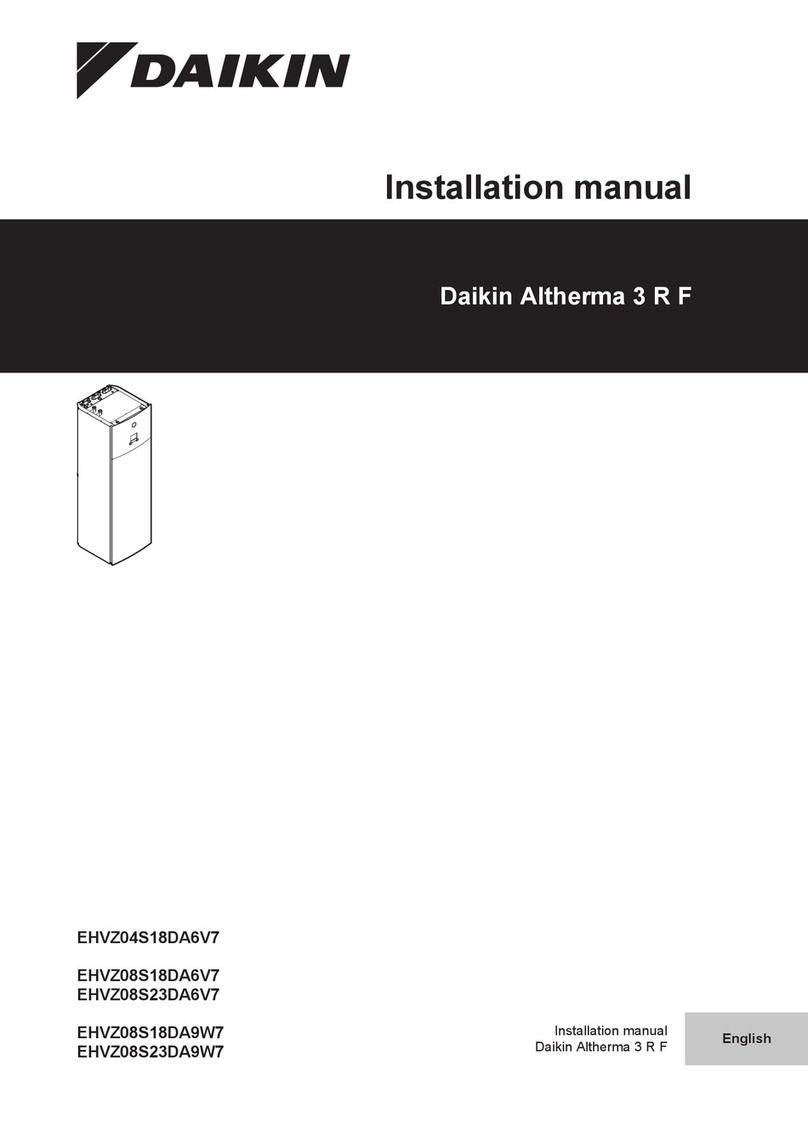
Daikin
Daikin EHVZ08S18DA6V7 installation manual
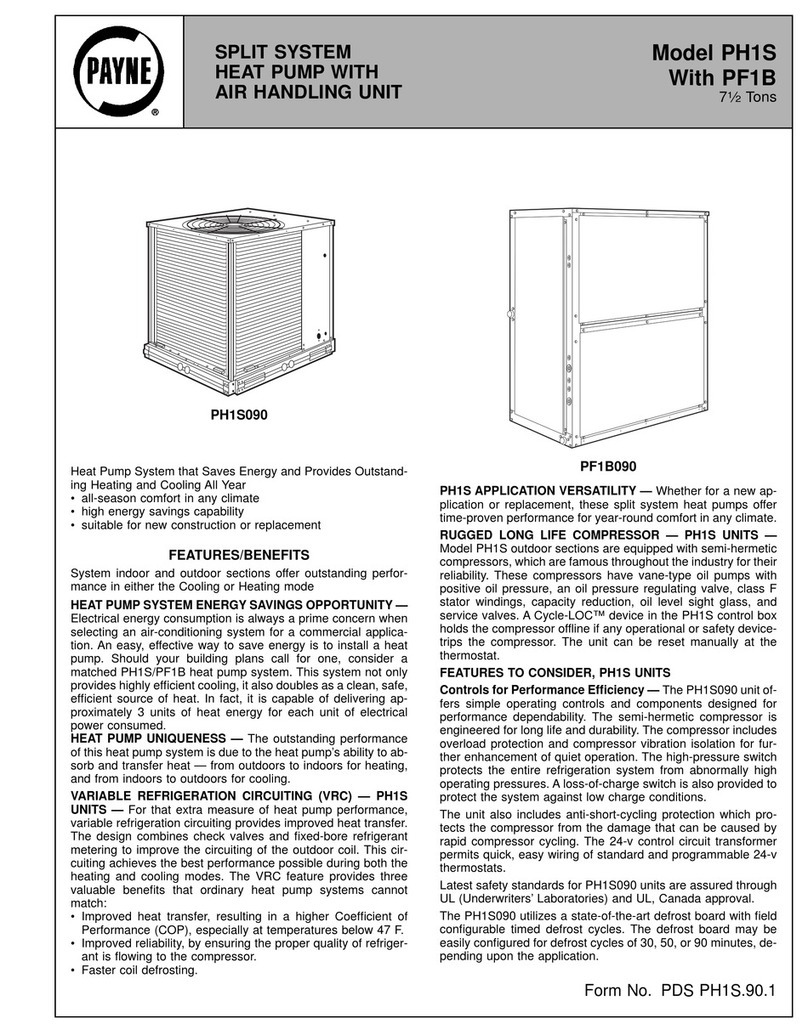
Payne
Payne PH1S manual

Sinclair
Sinclair Stherm SHP-140ECA Control and operation manual

Daikin
Daikin EHVH08SU26CB6W User reference guide

Viessmann
Viessmann VITOCAL 060-A Operating Instructions for the System User
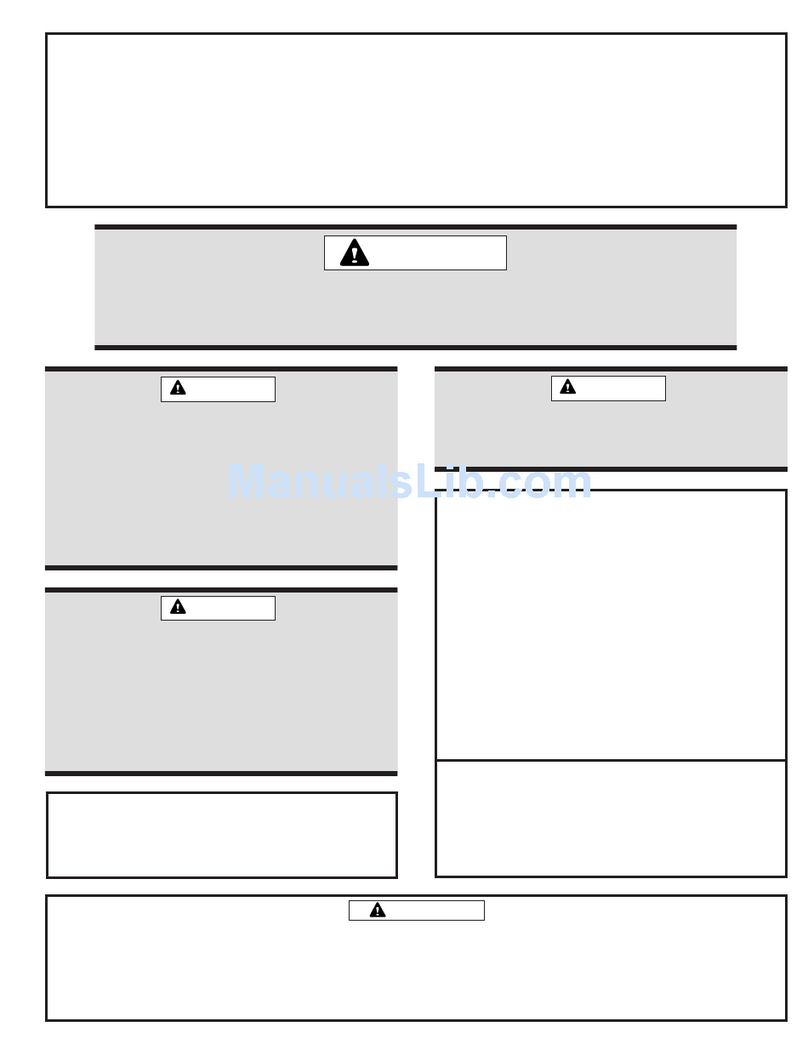
Lennox
Lennox (2/4)SH13 Installation and maintenance instructions

Grant
Grant Aerona HPAW110 Installation and user instructions
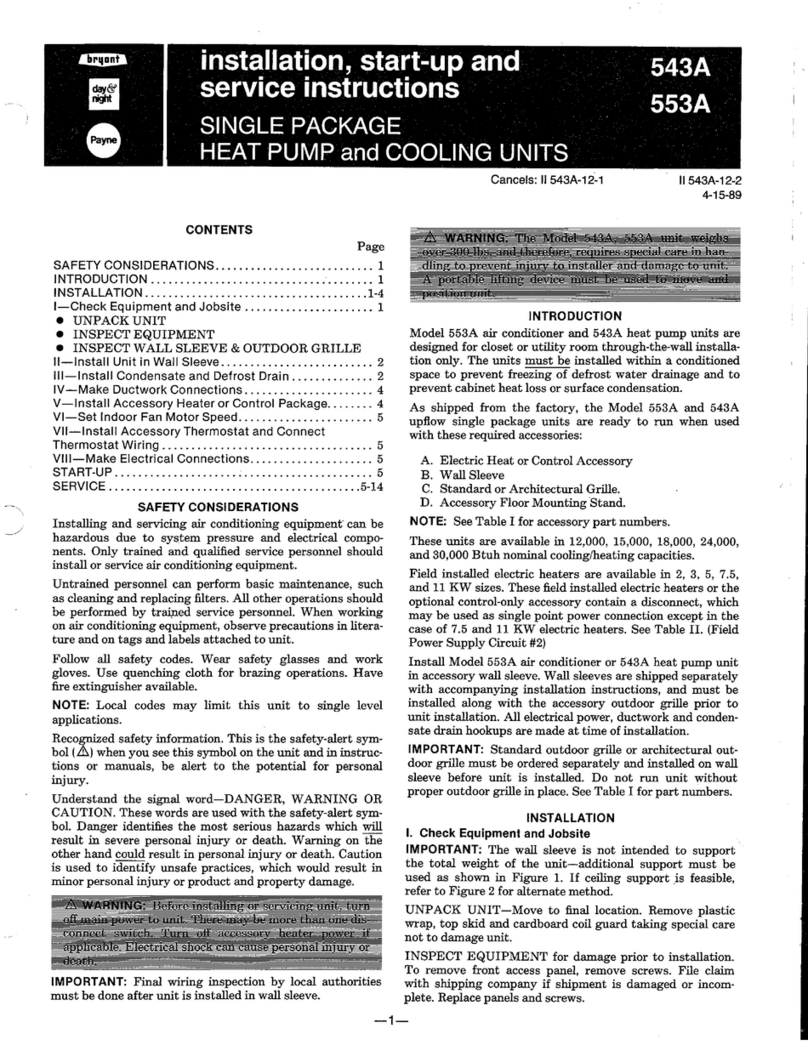
Bryant
Bryant 543A Installation, stat-up and service instructions
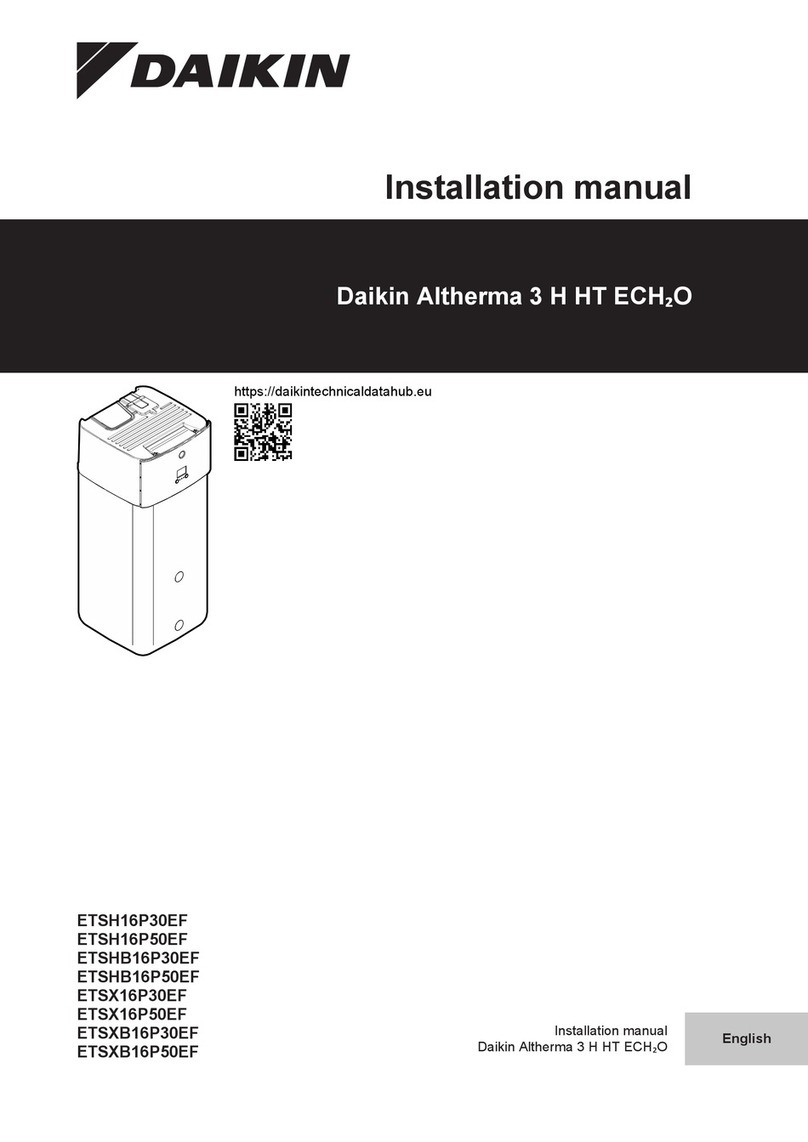
Daikin
Daikin ETSHB16P50EF installation manual

Tempstar
Tempstar N4H3 installation instructions
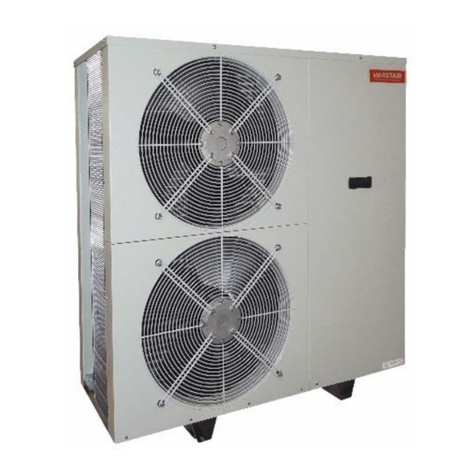
Marstair
Marstair MCU+ 180-200 Technical manual


